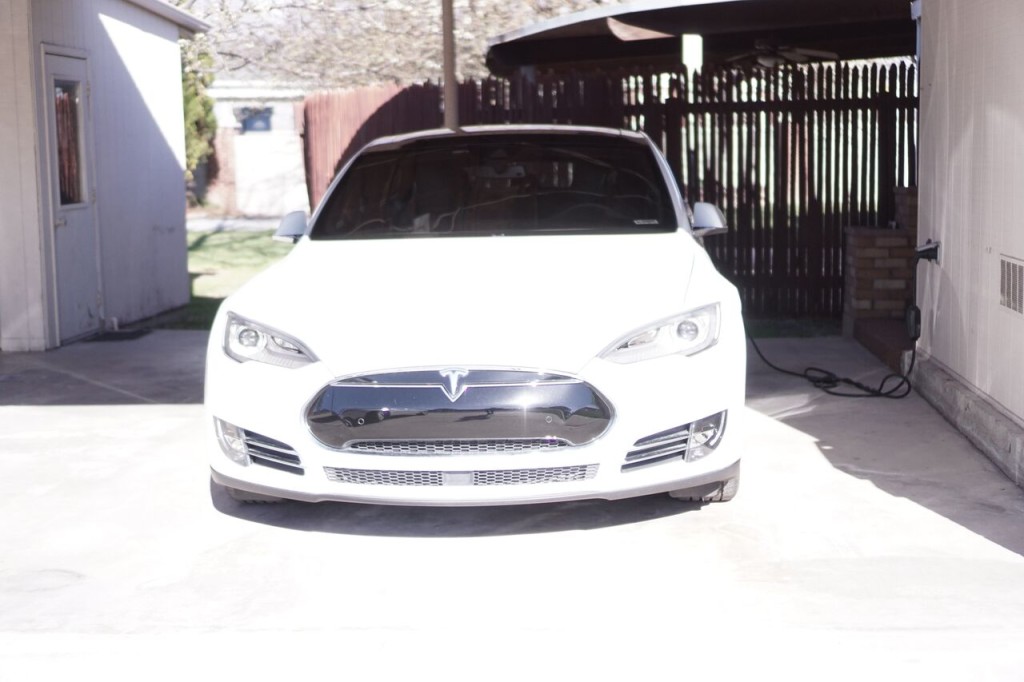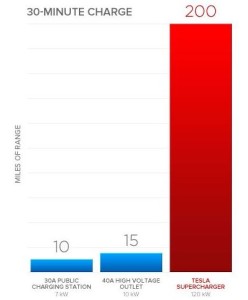1400 Miles of Non-Driving in a Tesla


I adapted very quickly to the new way of driving.
Although the MMM family leads an almost car-free life these days, I still find myself looking at and reading about the exuberant machines on a very regular basis.
It's a love/hate relationship because I've had some truly great times in cars, and I can appreciate the idea of a high-speed personal comfort bubble that lets you criss-cross the country with friends and stuff along for the ride. I love the beautiful curves, precise engineering, even the smell of hot tires just after you pull off the highway. But I hate what these cars have done for us collectively - vastly degrading the quality of our land and our bodies.
Because of all this, I've been following the radical change that has been creeping up on the world of cars and driving with extreme interest. This whole enormous scene we've come to accept as "normal", with the burning gas and crushed bodies, endless parking lots and driveways and traffic jams is balanced exactly where your bulky monochrome cell phone with the pull-up antenna was sitting in 1996. Although most people haven't noticed yet, it has just hit the tipping point and is about to enter a rapid fall and become something completely different.
Right now, most households have two low-efficiency gas burning cars or trucks which were bought with loans and consume money around the clock despite the fact that they are sitting idle 94% of the time. And we have given up most of the free land in our cities to roads and parking lots that sit idle a similar percentage of the time.
In a very short time, most cars will run on solar-generated electricity and you won't even want to own them - you'll just summon one with your phone and it will come pick you up autonomously and drive you to your destination. You can answer a few emails on the way in to work, or have a beer on the way down to the pub. And all this will be cheaper than the way we do things today. We'll also save trillions on parking lots, roads, traffic problems and road carnage.
It sounds impossibly futuristic, unless you know how surprisingly close we are to this technology right now. In fact, I took a trip straight to this future land, just last week.
1400 Miles in a Tesla Model S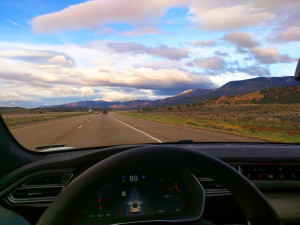
.
A friend of mine named Jesse runs a successful software company called You Need a Budget. Because of his active family and business life, he finds himself traveling around more often than I do. In conditions like these, it's very hard to resist buying a Tesla - just look at any Silicon Valley parking lot for proof - so I can't fault him for acquiring one. Instead, I decided to just make the best of it by accepting his invitation to take it for a multi-day test drive. Using the King for a Day principle, I figured I could harvest that first 75% of the joy of a fancy car that you get the first time you head out on a solid road trip.
But where to go? Jesse lives in Utah, and I live in Colorado. There was no practical way for me to arrange a long-duration test drive of this car, so instead I arranged a highly impractical one: a joint trip to Los Angeles.
There's always an excuse to visit LA, our nation's most outrageous combination of wealth, consumption and natural beauty. But in this case, I had really wanted to take a tour of a new peer-to-peer real estate investing company called PeerStreet after an invitation from the unusually sharp founders (more on this company in a coming article).
From our starting point near Salt Lake City to our seaside destination in Manhattan Beach, clear at the opposite edge of the LA megalopolis, was almost 700 miles. Across mountain ranges, empty deserts, a city called Beaver and another called Las Vegas.
Our car was the "base" version of the Tesla model S: a 514 horsepower, all-wheel drive electric car with a 70 kilowatt-hour battery pack. There's no gas tank, no engine, no muffler, no noise, two trunks, and seating for up to seven people. The current list price is about $75,000 USD, although federal and state tax credits can knock up to $12,500 off of that price depending on where you live. As Mr. Money Mustache, I'm obliged to state that this is not a reasonable amount of money to spend on a car. But if you have infinite money, it may be one of the less destructive indulgences.
The car sat glowing in the Utah sun as we walked up to the YNAB carport.
You already know from the news that these cars are fast and sexy runabouts for high-level tech workers and celebrities. But is it also a practical thing for cross-country travel? What if you run out of batteries? And what's this rumor about the car's "Autopilot" feature. Does it really drive itself?
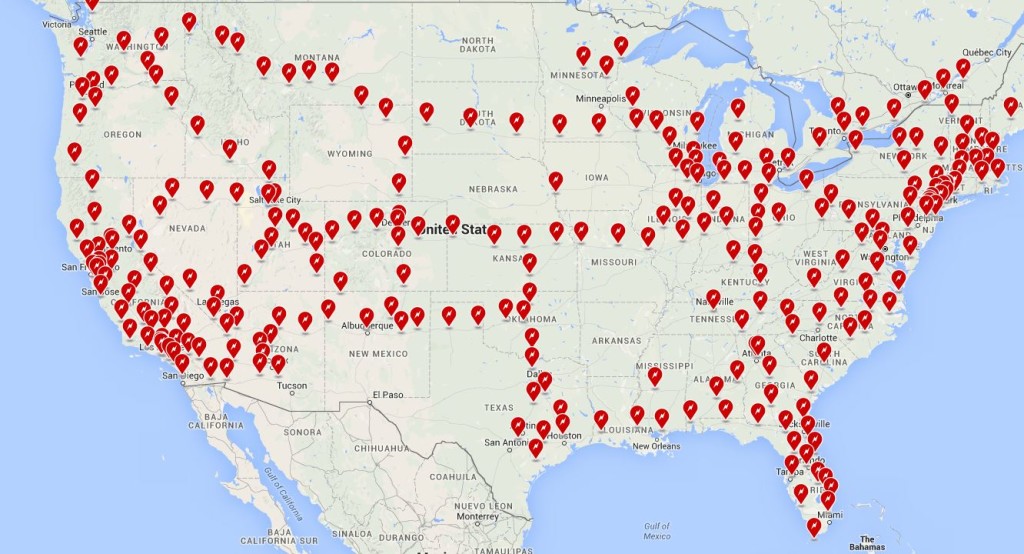
This is Tesla's network of free charging stations as of April 2015. More are going in every day, but in a pinch you can always use one of the other 27,000 or so public electric car charging stations that have sprung up, or charge at home. For comparison there are 168k gas stations in this country.
The quick answer is "Yes". While the rest of us were poking about burning gas and watching TV ads for pickup trucks, Tesla has quietly built something from about 20 years in the future and then plunked it down today. They have lined the nation's interstates and major cities with high-speed electric charging stations that dispense an unimaginably fast flow of power into your Tesla, allowing high-speed luxurious travel almost anywhere you'd want to go. And these gas stations are fueled with solar electricity. And they're automated, 24 hours a day, and they are free.
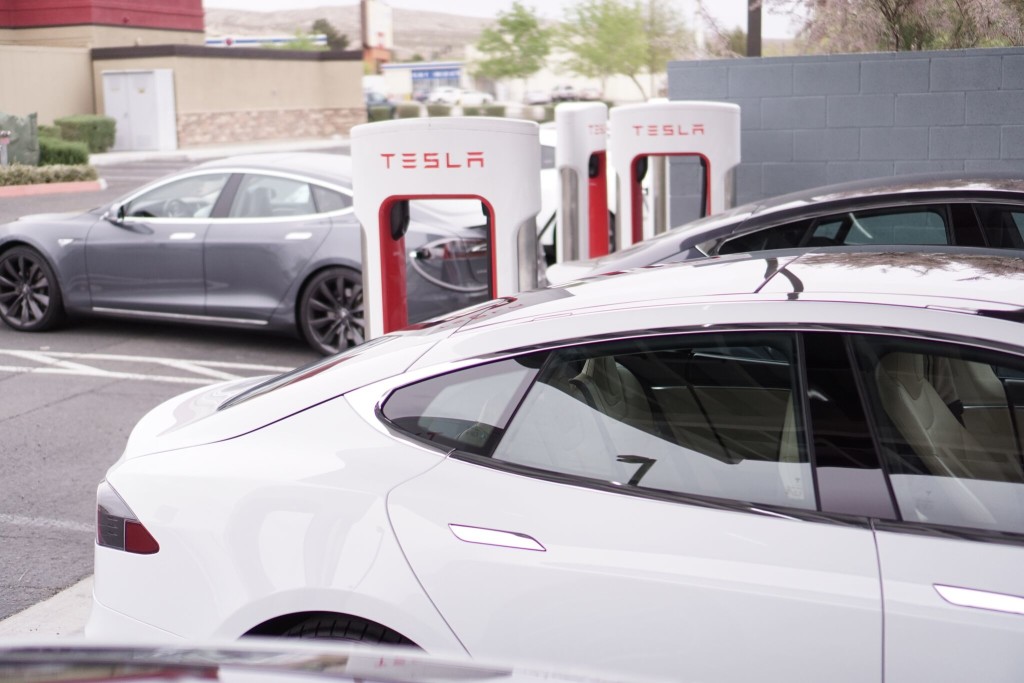
Catching a charge alongside several other travelers, somewhere in Nevada.
As an engineer, the charging network was actually the most impressive part of the Tesla experience to me. I can understand the basics of how you'd build a big battery, hook it up to some industrial-strength electric motors, and even use radars and sonars and cameras and plenty of software to allow a car to drive itself on the highway. But for a small newcomer to the auto market to install thousands of these chargers in the US, Europe, China and elsewhere in less than 3 years, about the time it takes a traditional automaker to redesign a headlight, is an astounding feat. Each station requires some sort of real estate negotiation, underground infrastructure, and a massively powerful transformer. And that's because the Tesla chargers are in a whole different universe than regular electric car chargers:
For comparison, I was thinking of buying a used Nissan Leaf and just charging it with a normal electrical outlet at home. This feeds 1300 watts into the battery and replenishes about 4 miles of driving range every hour. The Leaf and other low-end electric vehicles can also plug into higher-voltage charging stations and soak up 6600 watts, or in a few rare cases up to 40,000 if you can find an elusive "ChaDeMo DC Fast Charge" hookup. But the Tesla superchargers effortlessly put out 120,000 watts of recharge power, meaning the car charges at over 350 miles per hour. You can drive for 3 hours, then recover most of that charge in a little over 30 minutes.
The Surprisingly Civilized Rhythm of an All-Electric Roadtrip
It is this massive charging advantage that makes the Tesla the only car that is currently practical for fully electric cross-country road tripping. The base model has a 240 mile range between charges. I found this is accurate as long as you start with a full battery, run it right to the bottom, and keep your speed below 65 MPH. However, the spacing of the charging stations encourages a different pattern: lithium batteries prefer to operate in the 20%-80% range of charge. And humans prefer to drive sports cars at speeds greater than 65. So we had the car drive in the low 80s most of the time, and did more frequent recharging in the sweet spot of the battery range.
This still results in more frequent stops than you'd make in a gas car. But our group of travelers found the casual pace to be a very civilized experience. You travel swiftly for a couple of hours, then get out for a stretch and a walk before you get too cramped from sitting still. We often took time for a sit-down meal while the car was charging, something I never do on gas-powered roadtrips.
The Self-Driving Experience
Saving the best for last, the Tesla Model S has a feature that is at once completely revolutionary and instantly comfortable. If you're on a reasonable road with clear lane markings, the computer screen that sits where speedometers used to go will pop up an icon of a steering wheel. If you double-click a stalk near your turn signal, you'll hear a tone and find the car has taken over the driving. The lawyer-approved official text tells you to keep your hands on the wheel, but this is not necessary: I would lean back in my seat and stretch my arms out on the armrests while the car did everything perfectly.
Planting itself firmly in the center of the lane, the car ascends and descends curvy mountain canyon roads, tracks and responds to other vehicles and obstacles, and will brake and accelerate as necessary to flow with even the most intense traffic. If you flip the turn signal, it will look for a clear spot in the next lane and automatically change lanes.
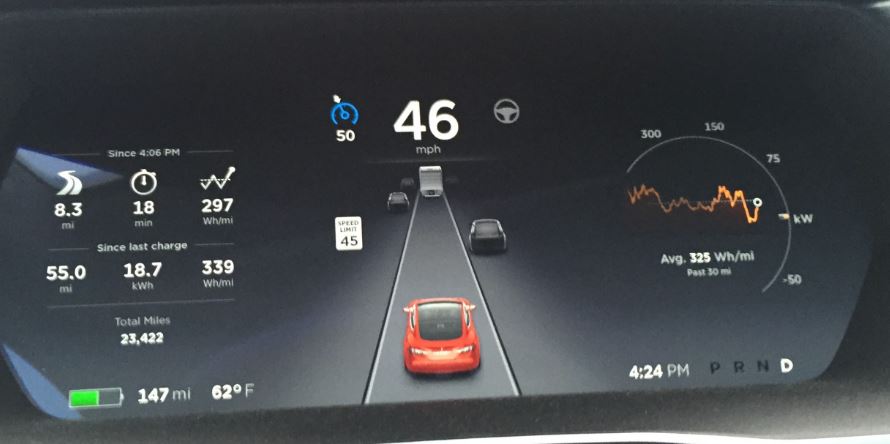
Autopilot builds a mental map of the vehicles around you, so it can respond to them as they move around.
There are well over 100,000* of these cars on the road, and they're all connected to the Internet and back home to Tesla through a cellular data connection. As their owners drive millions of miles per day, they behave as a giant learning swarm, aggregating the data and sending it back for statistical analysis. In practice, this means the autopilot system learns from experience and improves itself over time.
It already works pretty darned well from what I've seen. Although I enjoyed the effortless crossing of 600 miles of inland deserts and mountain ranges, the true joy came as we descended into the Los Angeles basin just in time for a Wednesday rush hour. With nearly perfect accuracy, Autopilot was able to glide me along through the endless traffic jams while I sat in the car's open, airy, and incredibly quiet interior, streaming music from my phone into the car's high-end audio system via Bluetooth, and enjoying conversation with my travel companions. It's more like sitting in a rolling leather-appointed coffee shop than the buzzing, stressful driving experience we all grew up with. The windshield wipers detected a light rain and wiped it away as needed, and the headlights took care of illumination whenever they deemed it to be a little dark.
The navigation system kept an eye on traffic and rerouted us whenever it could find a shortcut, and this was the only manual driving required. Autopilot can't (yet) help you exit the highway or make turns at intersections in the city. But the technology to do this is here today, and a huge number of the world's smartest people are scrambling to put it into place.
So How is This Even Remotely Mustachian?
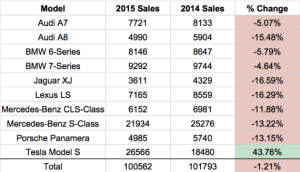
source: cleantechnica.com
After nearly 24 hours of driving this car and riding as a passenger, I found the idea of gas-powered cars being driven by hordes of inattentive, slow-reacting humans to be suddenly and hopelessly obsolete. While the Model S may be very expensive at the moment, it's actually one of the cheapest large luxury cars, because it competes against the fattest V-8 powered BMWs, Audis and Mercedes. As a result, The Tesla S is the best-selling luxury car in the US, claiming over 25% of the entire category in 2015.
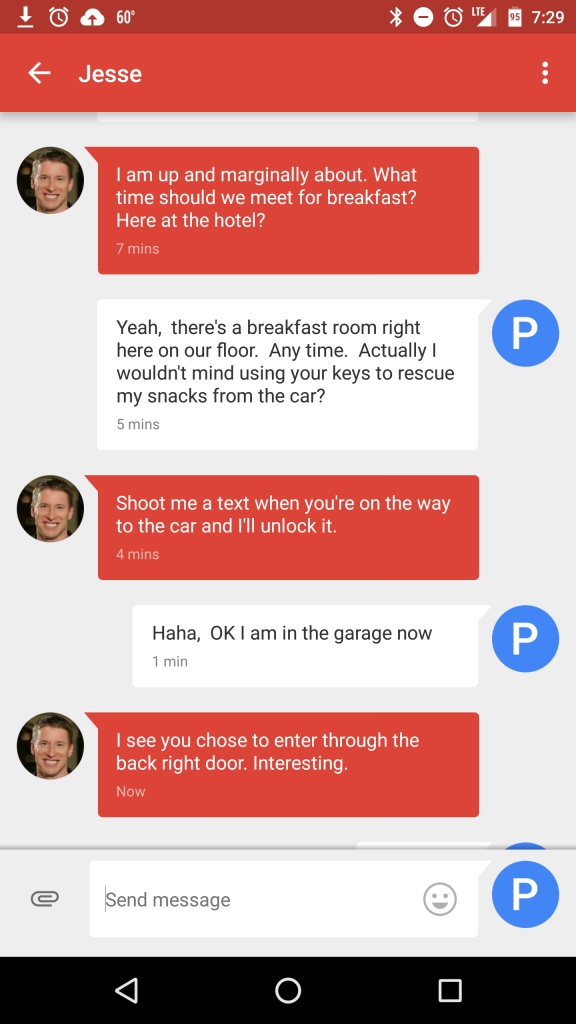
The "Gadget Factor" of being able to control your car from your phone is also appealing to many software types.
Although only multimillionaires should even consider buying a car this expensive, there's nothing inherently expensive about electric car technology in general. Almost half of the cost of this car is in the battery, and the price of that technology has been dropping like a stone - down by over 80% in just the last 10 years. Tesla just announced their next car, the Model 3, which is almost as good by any reasonable standard and will sell for $35,000. General Motors has a competing model called the Bolt that will be ready much sooner, and all the other car companies are scrambling to catch up.
But They're Still Just Luxury Electric Racing Wheelchairs
It was my privilege to be one of the first few people in the world to experience this decidedly better new way to drive across a country. But it's important to keep in mind that making better cars like these will only improve the world marginally. By switching to electric cars, we'll see our cities become quieter and cleaner and we'll save a few hundred thousand people from the meat-grinder of traffic collisions every year.
But the real way to win the car game is not to play it. The best life is spent not sitting on your buttocks within the confines of a car, but using the fine muscles within that curvaceous piece of engineering to thrust your legs downward as you provide your own propulsion. And that's why I'm excited about what Tesla is doing.
They started deliberately at the top of the market by making prestigious and fun toys for rich people, because we'll buy anything. But in the long run, the cars are destined to become ever-cheaper, and to be bought by the million by fleet companies like Uber. With cheap autonomous driving at our fingertips, you can summon a car for the time you need it, and then it can promptly go off and serve somebody else. Thus, we won't need to consume our cities with large parking lots, and we won't need huge garages at home. Automated electric vehicles of various sorts might even replace the expensive hassle of local-scale public transportation that we've struggled with for so long.
And with less-sprawled cities, we'll find more walking, more biking, and more tightly knit communities.
In short, it only takes a little bit of optimism to see a clear path between last week's experimental roadtrip in an expensive luxury car, and tomorrow's Badass Utopia.
* On Twitter, I recently made fun of the Organization of Petroleum Exporting Countries, which forecast that in the year 2040, electric cars would still only be 1% of the world's car sales. Two days later, Tesla pre-sold enough model 3s alone in three days to exceed that figure in the US market. I'm guessing that the whole exponential growth thing will surprise us as usual, and we'll see at least 80% of new cars are electric by that date.
